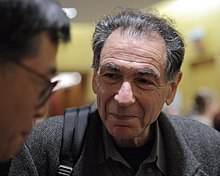Paul Forman
Paul Forman (* 1937 ) is an American historian of science and curator of the Department of Medicine and Science at the National Museum of American History . Forman's research focus is the history of physics , in which he pioneered the application of cultural and historical methods to scientific developments.
Forman has a doctorate in science history. His early work deals with the roots of quantum mechanics in the problems of the theory of atomic spectra, for example the anomalous Zeeman effect . From 1972 he worked at the Smithsonian Institution's National Museum of American History , where he became a curator in 1975.
He has been a Fellow of the American Physical Society since 1988 and of the American Association for the Advancement of Science since 1997 .
plant
Forman is best known for two controversial historical theses.
The first looks at the influence of German culture on the early development of quantum mechanics . He takes the view that the culture of the Weimar Republic, through what he calls its emphasis on non- causality , individuality and clarity, contributed to the acceptance and emergence of quantum mechanics. Forman also researched the funding of German science in the 1920s through the Notgemeinschaft der Deutschen Wissenschaft and the Helmholtz Society (the latter represented more Rhenish industrial interests). With Spencer Weart and John Heilbron, he published a comparative quantitative study in 1975 on the funding and staffing of science around 1900.
His second thesis considers the influence of military financing on the character and course of scientific research; He believes that the funding practice that was heavily focused on military applications during World War II and the Cold War resulted in a shift in physics from basic to applied research. In this context, he examined, among other things, the development of physics in the USA in the 1950s that resulted from radar research during World War II, for example in the development of the Maser . As part of his investigations into the legacy of radar research, Forman also researched the history of atomic clocks and the history of microwave spectroscopy with Isidor Isaac Rabi .
literature
- Carolyn Carson, Alexei Kojevnikov, Hellmuth Trischler: Beyond Weimar culture - the meaning of the Forman thesis for a history of science from a cultural-historical perspective, Ber. History of Science, Volume 31, 2008, pp. 305-310
Web links
References
- ^ Forman: Alfred Landé and the Anomalous Zeeman Effect, 1919–1921. In: Historical Studies in the Physical Sciences . Volume 2, 1970, pp. 153-261
- ^ Forman: The Doublet Riddle and Atomic Physics circa 1924. In: Isis . Volume 59, 1968, pp. 156-174
- ^ Forman: Weimar culture, causality, and quantum theory: adaptation by German physicists and mathematicians to a hostile environment. In: Historical Studies in the Physical Sciences . Volume 3, 1971, pp. 1-115. Expanded further in Forman: Causality, Clarity and Individuality, or How Cultural Values Prescribed the Character and Lessons Ascribed to Quantum Mechanics. In: Nico Stehr and Volker Meja (editors): Society and Knowledge . Transaction Books, 1984, pp. 333-347. Criticism, for example, from P. Kraft and P. Kroes: Adaptation of Scientific Knowledge to an Intellectual Environment. Paul Formans 'Weimar Culture and Quantum Theory, 1918-1927'. Analysis and Criticizm . In: Centaurus . Volume 27, 1984, pp. 76-99
- ^ Forman: The Financial Support and Political Alignment of Physicists in Weimar Germany. In: Minerva . Volume 12, 1974, pp. 39-66
- ^ Forman, Heilbron, Weart Physics circa 1900: Personnel, Funding, and Productivity of the Academic Establishments , Historical Studies in the Physical Sciences, 5, 1971, 1-185
- ^ Forman: Behind quantum electronics: National security as basis for physical research in the United States, 1940-1960 . In: Historical Studies in the Physical and Biological Sciences . Volume 18, 1987, pp. 149-229.
- ^ Forman: Into quantum electronics: the maser as gadget of Cold-War America. In: Paul Forman and José M. Sánchez-Ron (editors): National Military Establishments and the Advancement of Science and Technology: Studies in Twentieth Century History . Kluwer, Dordrecht 1996, pp. 261–326
- ↑ Forman: Swords into plow shares': breaking new ground with radar hardware and technique in physical research after World War II. In: Reviews of Modern Physics . Volume 67, 1995, pp. 397-455
| personal data | |
|---|---|
| SURNAME | Forman, Paul |
| BRIEF DESCRIPTION | American historian of science |
| DATE OF BIRTH | 1937 |
